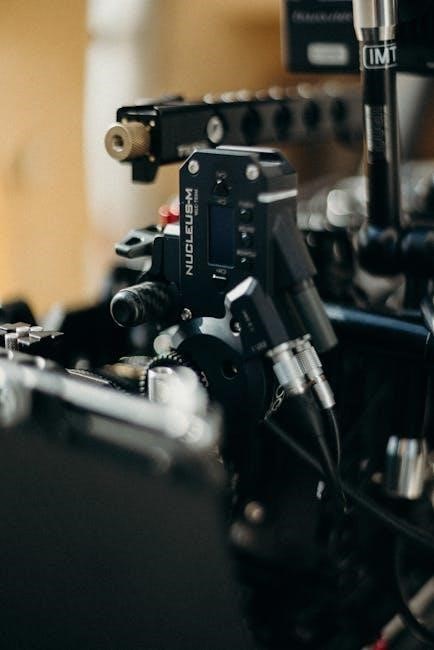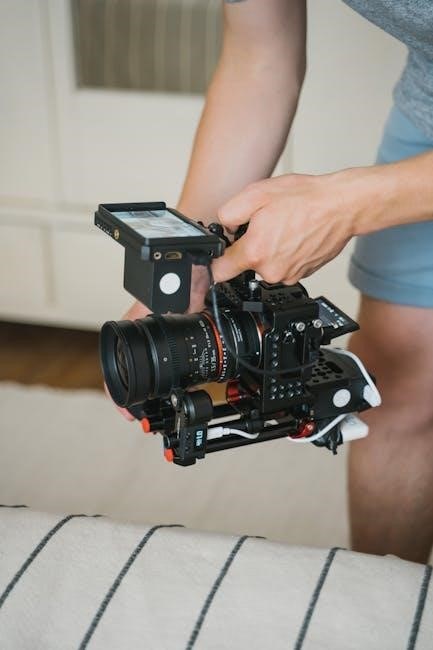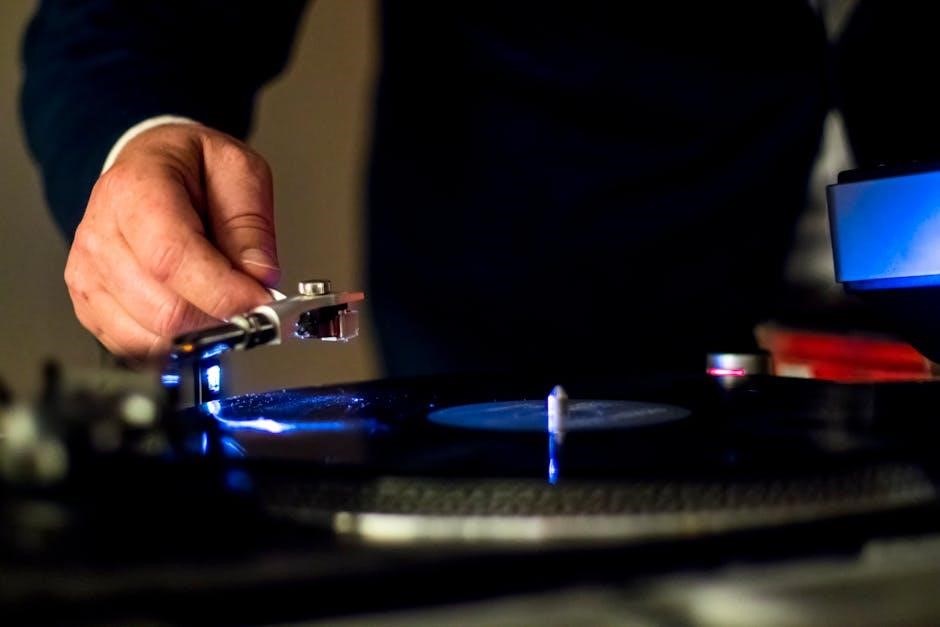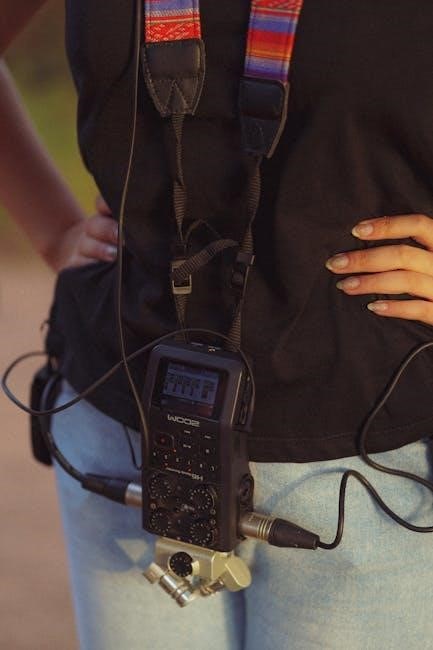The Bravo Reflux Recorder Manual is a comprehensive guide for patients and clinicians, detailing the system’s setup, usage, troubleshooting, and data interpretation for accurate GERD diagnosis․
Overview of the Bravo Reflux Recorder
The Bravo Reflux Recorder is a wireless, calibration-free system designed to monitor gastroesophageal reflux disease (GERD)․ It uses a small pH capsule placed in the esophagus to record acid reflux events over 48 to 96 hours․ The system captures data on reflux frequency, duration, and correlation with symptoms like heartburn, providing detailed insights for accurate diagnosis and treatment planning․
Purpose and Benefits of the Bravo Reflux Recorder
The Bravo Reflux Recorder aims to accurately diagnose and monitor GERD by measuring esophageal pH levels․ Its benefits include non-invasive placement, wireless data transmission, and a prolonged monitoring period of up to 96 hours․ This allows for a comprehensive assessment of reflux patterns and symptoms, enhancing treatment efficacy and patient care․ The system is both patient-friendly and clinically reliable, providing actionable data for healthcare providers․

Key Features of the Bravo Reflux Recorder
The Bravo Reflux Recorder offers wireless pH monitoring, calibration-free design, and extended recording up to 96 hours, ensuring accurate and reliable GERD diagnosis and monitoring․
Wireless pH Monitoring System
The Bravo Reflux Recorder utilizes a wireless pH monitoring system, eliminating the need for cumbersome wires․ This allows for greater patient mobility and comfort during the 48- to 96-hour monitoring period․ The system accurately captures esophageal pH levels, correlating reflux episodes with symptoms like heartburn and regurgitation․ Data is transmitted securely to the receiver, enabling precise tracking and analysis․ This feature enhances patient compliance and provides reliable diagnostic results․
Calibration-Free Design for Enhanced Accuracy
The Bravo Reflux Recorder features a calibration-free design, ensuring consistent and precise pH measurements without the need for manual adjustments․ This eliminates potential errors associated with traditional calibration processes, providing highly accurate data collection․ The system’s advanced technology maintains reliability throughout the monitoring period, delivering trustworthy results for diagnosing GERD and assessing treatment effectiveness․ This design simplifies the testing process for both patients and healthcare providers, enhancing overall efficiency and accuracy․

Preparing for the Bravo Reflux Test
Preparing for the Bravo Reflux Test involves discontinuing reflux medications, ensuring the recorder is fully charged, and avoiding tight clothing for optimal sensor placement․ Follow all pre-test guidelines carefully․
Pre-Test Instructions and Guidelines
Before the Bravo Reflux Test, discontinue all reflux medications to ensure accurate readings․ Avoid eating acidic or fatty foods 24 hours prior․ Wear loose, comfortable clothing for optimal capsule placement․ Charge the recorder fully and keep it accessible․ Record all symptoms in the provided diary and press the symptom button when symptoms occur․ Follow the nurse’s instructions for proper test preparation and duration․
Discontinuing Reflux Medications Before the Test
Patients must stop taking reflux medications 7-10 days before the test to ensure accurate results․ This includes proton pump inhibitors, antacids, and histamine-2 receptor blockers․ Discontinuing these medications allows natural acid production to be measured․ Consult your physician before stopping any prescribed medication to avoid complications․ This step is crucial for obtaining reliable data during the 48- to 96-hour monitoring period․

Setting Up and Placing the Bravo Capsule
The Bravo Capsule setup involves attaching the wireless device to the esophagus using an endoscope․ The procedure ensures accurate pH monitoring for reflux episodes, providing patient comfort and safety during the 48- to 96-hour test period․
Step-by-Step Placement Procedure
The placement begins with inserting an endoscope through the nose or mouth to locate the esophagus․ The Bravo Capsule is then attached to the esophageal lining, 6-7 centimeters above the lower esophageal sphincter․ A nurse or technician ensures proper adhesion and verifies the capsule’s placement using a video monitor․ Patients may experience mild discomfort but can resume normal activities post-procedure․
Ensuring Proper Placement for Accurate Results
Proper placement of the Bravo Capsule is crucial for accurate data collection․ The capsule is positioned 6-7 cm above the lower esophageal sphincter, verified via endoscopic visualization and real-time pH monitoring․ Incorrect placement can lead to inaccurate readings․ A healthcare professional ensures the capsule adheres correctly, and patients are monitored post-placement to confirm proper positioning and functionality․
Monitoring and Data Collection with the Bravo Recorder
The Bravo Recorder captures reflux episodes and pH levels, correlating symptoms with data․ Patients log symptoms using buttons, ensuring accurate correlation during the 48- to 96-hour monitoring period․
How the Recorder Captures Reflux Data
The Bravo Recorder continuously monitors esophageal pH levels, detecting acid reflux episodes in real-time․ It wirelessly receives data from the capsule, logging symptoms when patients press the symptom button․ The system captures reflux frequency, duration, and correlation with symptoms, storing data for up to 96 hours․ This detailed recording helps clinicians assess GERD severity and tailor treatment plans effectively․
- Records pH levels and reflux events․
- Tracks symptoms like heartburn and regurgitation․
- Stores data for 48 to 96 hours․
Understanding the 48- to 96-Hour Monitoring Period
The Bravo Reflux Recorder captures data over 48 to 96 hours, providing a detailed assessment of acid reflux patterns and symptom correlation․ This extended monitoring period ensures comprehensive insights into GERD severity, allowing clinicians to observe reflux episodes, symptom triggers, and responsiveness to conditions․ The adjustable duration accommodates individual patient needs, offering a robust dataset for accurate diagnosis and treatment planning․

Recording Symptoms During the Test
Press the symptom button to log heartburn, regurgitation, or chest pain, helping correlate symptoms with reflux episodes for precise diagnosis and effective treatment planning․
Identifying and Documenting GERD Symptoms
Common GERD symptoms include heartburn, regurgitation, chest pain, coughing, and burping․ Documenting these during the test helps correlate them with reflux episodes․ Use the recorder’s symptom buttons to log events and note severity in a diary․ This data aids in pinpointing triggers and assessing symptom-reflux associations, ensuring accurate diagnosis and personalized treatment plans․
Using the Symptom Button for Accurate Logging
Press the symptom button on the recorder when you experience GERD symptoms like heartburn, regurgitation, or chest pain․ Ensure the backlight is on before pressing․ This logs events accurately, helping correlate symptoms with reflux episodes․ If the recorder beeps, hold it to your chest for 30 seconds to reset․ Consistent logging enhances diagnostic accuracy and personalized treatment plans․

Interpreting the Data and Results
The Bravo Reflux Recorder provides detailed pH level readings and reflux episode tracking․ Analyzing this data helps identify patterns and correlations between symptoms and acid exposure, aiding precise GERD diagnosis․
Understanding pH Levels and Reflux Episodes
The Bravo Reflux Recorder measures esophageal pH levels to detect acid reflux episodes․ Normal pH levels typically range from 4 to 7, while reflux episodes are indicated by drops below pH 4․ The system records the frequency, duration, and severity of these episodes․ Correlating these data points with symptoms like heartburn helps clinicians assess GERD severity and determine appropriate treatment plans․ The recorder captures reflux patterns over 48 to 96 hours, ensuring comprehensive insights․
Correlating Symptoms with Recorded Data
Correlating symptoms with recorded data involves matching patient-reported GERD symptoms, such as heartburn or regurgitation, with Bravo Reflux Recorder data․ This helps identify patterns between acid reflux episodes and symptom occurrence․ The symptom button logs events, allowing clinicians to analyze correlations and confirm whether symptoms align with pH drops․ This integration aids in diagnosing GERD severity and tailoring treatment plans effectively․ Accurate correlation enhances the reliability of test results for personalized care․

Post-Monitoring Procedures
After monitoring, safely remove the Bravo capsule and return the recorder․ Follow healthcare instructions for proper disposal and completing the test․ Ensure all data is submitted accurately․
Removing the Bravo Capsule Safely
The Bravo capsule is typically removed via endoscopy or naturally passes through digestion․ Patients should avoid pulling or tugging the capsule․ Follow healthcare provider instructions for safe removal․ Ensure the recorder is returned after the procedure․ Proper disposal methods are outlined in the manual to maintain patient safety and device integrity․ Always seek professional guidance for any concerns during removal․
Returning the Recorder and Completing the Test
After the monitoring period, return the recorder to your healthcare provider․ Ensure all data is downloaded and stored securely․ Patients should complete a post-test questionnaire to share feedback․ Proper handling ensures accurate results and device maintenance․ Follow provided instructions for return shipping if applicable․ Confirmation of successful data submission marks the completion of the test process, allowing your physician to review and diagnose effectively․

Troubleshooting Common Issues
Troubleshooting involves resolving connectivity or beeping issues․ Restart the device or reposition it if beeping occurs․ Consult the manual for detailed solutions or contact support for assistance․
Resolving Connectivity or Beeping Problems
If the Bravo recorder beeps, it may indicate connectivity issues or distance from the receiver․ Press the symptom button to check functionality․ Ensure the recorder is within 3 feet of your chest․ If beeping persists, hold the recorder to your chest for 30 seconds to recalibrate․ Restart the device if necessary․ Connectivity problems often occur due to proximity to electronics․ Consult the manual for detailed troubleshooting steps or contact support for further assistance․
Addressing Recorder Malfunctions During the Test
If the Bravo recorder malfunctions, ensure it is within 3 feet of your chest and not near other electronics․ Restart the device if necessary․ Check the symptom button functionality and ensure the backlight is on․ If issues persist, contact your healthcare provider promptly to avoid data loss․ Regular checks and following manual guidelines can help prevent interruptions during the 48- to 96-hour monitoring period, ensuring accurate GERD diagnosis and effective treatment planning․

Safety Precautions and Contraindications
The Bravo Reflux Recorder is not MRI-compatible and should avoid exposure to strong magnetic fields․ Contraindications include implanted medical devices or pregnancy․ Consult your physician before use․
Important Safety Information for Patients
Patients should avoid MRI scans while using the Bravo Reflux Recorder․ The device is not compatible with MRI machines and may cause injury․ Additionally, individuals with implanted medical devices, such as pacemakers, should not use this system․ Pregnant women and those with certain medical conditions must consult their physician before proceeding with the test․ Proper usage ensures accurate results and patient safety․
Contraindications for the Bravo Reflux Recorder
The Bravo Reflux Recorder is contraindicated for patients with pacemakers or other implantable electronic devices․ It is also not recommended for individuals with active esophageal bleeding or strictures․ Patients who are pregnant or have certain metal allergies should consult their physician․ Additionally, the device is not suitable for individuals requiring MRI scans during the monitoring period․ Proper screening ensures safe and effective use of the system․
The Bravo Reflux Recorder provides valuable insights into GERD, enabling accurate diagnosis and treatment․ Follow all guidelines for optimal results and consult your physician for next steps․
Final Thoughts on Using the Bravo Reflux Recorder
The Bravo Reflux Recorder is a valuable tool for diagnosing GERD, offering precise data on acid reflux episodes․ Patients should follow all guidelines, press buttons for symptoms, and keep the recorder within range․ After the monitoring period, return the device to your physician for analysis․ This test provides critical insights, enabling personalized treatment plans for improved health outcomes․
Next Steps After Completing the Test
After the monitoring period, return the Bravo recorder to your physician․ Schedule a follow-up appointment to review your results and discuss treatment options․ Your doctor will analyze the data to determine the severity of acid reflux and recommend appropriate therapies․ This may include lifestyle changes, medication adjustments, or further testing․ Be sure to ask any questions and seek guidance on managing symptoms effectively․
